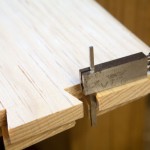We may receive a commission when you use our affiliate links. However, this does not impact our recommendations.
If you think there are hard-and-fast rules about designing dovetails, don’t read any further. You’ll get an ulcer.
North Carolina woodworker Mark Firley has collected a set of 472 photos of dovetails on antiques that he has collected in his travels all over the United States. Sift through this set, and you can find almost every possible layout scheme imaginable.
You’ll find sloppy and tidy tails. Skinny pins and corpulent ones. And slopes that go from almost vertical to – I swear it – 45°.
If you don’t get out much to inspect old work, here is a quick and painless education in the wide variety of ways you can cut this joint.
Visit the set of photos here. Remember that you can click on each photo and enlarge it.
And thanks to Mark for making this set available for everyone.
— Christopher Schwarz
Here are some supplies and tools we find essential in our everyday work around the shop. We may receive a commission from sales referred by our links; however, we have carefully selected these products for their usefulness and quality.











Wow. Lots of effort went into gathering that collection. Great to see the many variations and over cuts. I don’t know if I found an antique on the street the other night or just a home made piece of furniture now. I was wondering if you could answer a question about something else in picture 34 ( I think ) abou the wood. I’m wondering which wood the veneer is?? It’s a squiggly grain to my eye. I’d appreciate any help. Cheers 🙂
Well said, Mark! This was commerce, not art. More importantly, these craftsman were not cutting perfect dovetails to be photographed by woodworking magazines to impress other woodworkers. They wanted drawers that worked and they didn’t want call backs from clients. The current obsession with perfection is driven by slick magazine covers, and that may well have given birth to a modern market for protection in handmade furniture. But as shown in these photographs, and by my own experience as a restorer, it isn’t really historic. Thanks for the huge collection of photos. They help bring us all back to reality.
I’m glad we are on dovetails.
Cut out my very first set a few days ago, and i couldn’t be happier. Of course, they are probably as botched up as any other first timer’s, but guess what they hold together just fine. I think I’ll write a blog post on it later today…
Thanks for the heads up Chris, much obliged1
Albert
472 pictures, but one important variant was left out. Check here: https://www.popularwoodworking.com/article/the-impossitails-zone. And here: https://www.popularwoodworking.com/woodworking-blogs/chris-schwarz-blog/when-you-run-out-of-material. No dovetail compendium is complete without these mystery marvels.
The variety of dovetails here is the best argument for NOT using a router jig. The diversity of surprising and handsome joints outweighs the clunkers.
Didn’t know you were a dovetail groupie….
What’s the wood-engineering theory behind pin size and number of pins vs. tails? Isn’t it a balance of the strength between two grain directions? Has the magazine ever considered doing a strength test with dovetails like it did with mortise and tenons a while back?
Cutting past the baseline: Not quite compulsory, but highly recommended. Apparently!